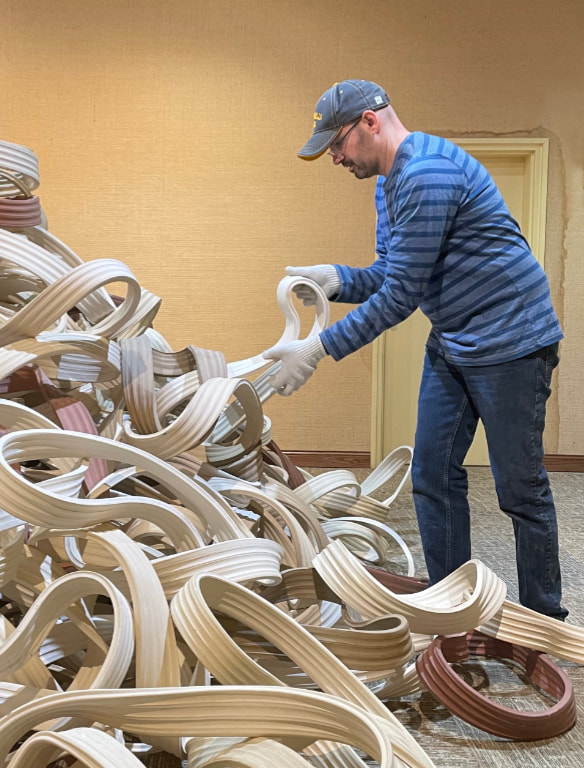|
Faculty Spotlight: Ned Day, Art Institute Written by Dan Seibel On any given summer's morning, you might find Ned Day standing over an eighteen-hundred-degree kiln pulling out a perfectly formed ceramic bowl alongside a young artist. A bit later, you might spot him on the choppy waters of Antelope lake in his kayak, taking in the views of Sinte Gleska's campus from a different angle. And in the evening, you just might run into him loading up two hundred individual pieces of an art installation into a U-Haul for an exhibit halfway across the country. No matter where you find him, he'll probably greet you with his trademark grin and nod, happy to share a moment of connection. Originally from Miller (near Kearney), Nebraska, Ned day found a new home at Sinte Gleska University in 2013 when he joined the faculty at the Great Plains Art Institute under the leadership of Maggie MacKichan. Ned brought with him to SGU a decade of experience in the field, including six years as an art director for Cabela's catalog, as well as years of experience in community art education. He built on his background in graphic design with a Master's in Fine Arts from Fort Hays University where he studied ceramics, sculpture, and art history with the hope of becoming an educator. "For me, Sinte Gleska was an opportunity to help students follow their artistic aspirations in an intimate environment while staying close to home," Ned explains. "I enjoy how it has become like a family and I get to be part of students' journeys as they progress." For nearly ten years he has been a steady presence in the lives of students and the campus community at SGU teaching classes, running art shows with Maggie, volunteering on committees, taking students on trips, and simply enjoying life on the prairie. When asked about the future, Ned shares his excitement about building in more offerings in traditional arts at the University and continuing to cover a wide variety of disciplines in the Art Institute. That and watching SGU art students return home with another pile of awards from the latest art show.
1 Comment
Maštiŋčala Čohwaŋjiča na Činčoge El Uŋpi Ehaŋna Lakh́ota Woyákapi: Wičaša waŋ tí ča el maštiŋčala eya wači ipi na maštiŋčala kiŋ wačipi na heyápi: Čiye, maštiŋ kokípápi najiŋ ye, eyápi ške. Čaŋke wičaša waŋ el wači ipi kiŋ hé hinápiŋ na héya ške: Misuŋ, taŋyaŋ el wači mayáhipelo ča makoče waŋ čičupi ča el yauŋpi kte lo. Heče čohwaŋjiča oju na č’iŋčoǵa kiŋ hé makoče kiŋ čičupi ča el yauŋpi kte lo. Eya ške. Eyé kiŋ héoŋ heče ča makoče el uŋnpi. Héoŋ lehaŋl čohwaŋjiča na čiŋčoǵe oju el maštiŋčala kiŋ uŋpi oŋ hečetu. Hehaŋyela Oihaŋke. The Rabbit They Live in Willows and Driftwood Once upon a time the Lakota related: There were some rabbits who went to dance at a man’s house; the rabbits danced, and they said this: “Big Brother, rabbits stand in fear, they said. And so, when they came to him, the man came out, and he said: “my little brothers, since it is well you came to me to dance, I shall give you a piece of land where you might live. In this place I give you, you will live in a willow patch and a land of dry driftwood. Because he said in this place, they lived there in the countryside. For that reason, it is well now for rabbits to live in patches of willow and dry driftwood. That is all, the end. On a note: a rabbits’ friendly habitat, appropriate environment for every creature, when in need of help, creatures seem to turn to man for a place of food and protection. |
Strengthening the Circle :
|
- About
- Quick Links
- News
- Governance
- Discover SGU
-
Student Life
- Facts and Figures
- Online Learning Support
- New Student Info/Registration
- Research Review Board >
- 2023 Graduation Ceremony
- 2023 Graduate Photos
- Student Association
- Literacy Center
- Disability Services
- Counseling Services
- Child Care
- Transportation
- Security
- Bookstore
- Library
- Web Mail
- What You Can Do At SGU
- Poll
- Student Opportunities
- After Graduation
-
Departments
- Staff
- Giving
- Board Minutes
Mailing Address: Po Box 105/Mission, SD/57555
Shipping Address: 101 Antelope Lake Circle/Mission,SD/57555
605-856-8100
Shipping Address: 101 Antelope Lake Circle/Mission,SD/57555
605-856-8100
Accreditation and Sinte Gleska University – A Short History
Sinte Gleska University has been accredited by the Higher Learning Commission (HLC – formerly the North Central Association) since 1983. Because SGU is accredited, colleges and universities across the United States will review courses that students take at SGU and will consider them for transfer.
For more information, and to see the most recent correspondence from HLC to SGU, click on the HLC logo
Sinte Gleska University has been accredited by the Higher Learning Commission (HLC – formerly the North Central Association) since 1983. Because SGU is accredited, colleges and universities across the United States will review courses that students take at SGU and will consider them for transfer.
For more information, and to see the most recent correspondence from HLC to SGU, click on the HLC logo
All Media on this site ©2023 Sinte Gleska University.
Do not use without permission. Sinte Gleska University and the Sinte Gleska University Logo are Protected and Registered Trademarks.
Not to be used without permission.See HERE for legal information
Do not use without permission. Sinte Gleska University and the Sinte Gleska University Logo are Protected and Registered Trademarks.
Not to be used without permission.See HERE for legal information


 RSS Feed
RSS Feed
